'I'll see you after the war'
Jerusalem/Gaza Strip - It all happened very quickly. It was just after sunset in Jerusalem on Friday May 7, we were dipping our fingers into the perfectly-rolled juicy stuffed olive leaves, ladening our plates with delicious fattoush salad, meat and aromatic cardamom-spiced rice, when our WhatsApp messages started frantically pinging: Unrest at al-Aqsa mosque!
For weeks, night-time protests on the compound of the mosques in east Jerusalem had caused sleepless nights for photographer Ahmed Gharabli. We were already on our knees, and the only thing on our minds was the evening iftar, the meal to break the fast on the last Friday of the holy month of Ramadan, to be rounded off with a chat, and a smoke of a shisha under the quiet of the apricot trees. But the calm was broken. Exhausted, Ahmed stood up. ‘I’m going to al-Aqsa’: he said.
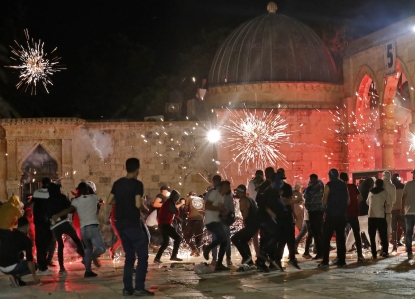 Stun grenades burst in the air amid clashes between Palestinian protesters and Israeli security forces at the al-Aqsa mosque compound in Jerusalem, on May 7, 2021. (AFP / Ahmad Gharabli)
Stun grenades burst in the air amid clashes between Palestinian protesters and Israeli security forces at the al-Aqsa mosque compound in Jerusalem, on May 7, 2021. (AFP / Ahmad Gharabli)
We’d been expecting some protests, maybe some injured, but not really what followed next. Heavy clashes broke out during the night between Palestinians and Israeli police on the mosque esplanade, the third holiest site in Islam, and the place where the second intifada was born in 2000.
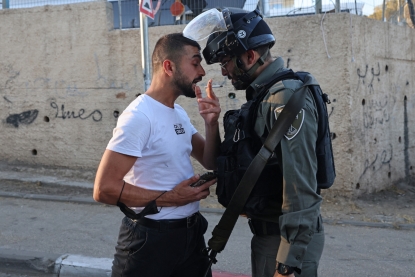 A Palestinian argues with a member of Israeli security forces in the east Jerusalem neighbourhood of Sheikh Jarrah, where looming evictions of Palestinian families have fuelled anger, on May 15, 2021 (AFP / Emmanuel Dunand)
A Palestinian argues with a member of Israeli security forces in the east Jerusalem neighbourhood of Sheikh Jarrah, where looming evictions of Palestinian families have fuelled anger, on May 15, 2021 (AFP / Emmanuel Dunand)
The violence worsened over the following nights, and it was early Monday morning when chaos broke loose. “Guillaume, there are clashes at al-Aqsa, there are wounded everywhere,” Ahmad told me on the phone. One hundred, 200, 300, 400, 500, the toll reported by rescuers kept rising. On the AFP wire, it was raining breaking news alerts.
Hospitals were quickly overwhelmed with the injured as Israel marked ‘Jerusalem Day’ which in the Hebrew calendar marks the day that Israel seized east Jerusalem from Jordanian control in 1967.
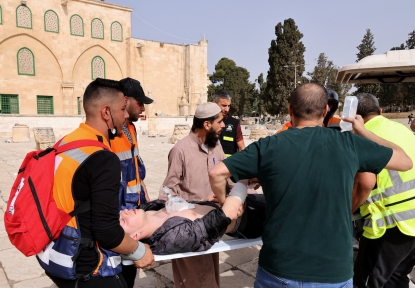 Palestinian medics evacuate a wounded protester amid clashes with Israeli security forces at Jerusalem's Al-Aqsa mosque compound on May 10, 2021 (AFP / Ahmad Gharabli)
Palestinian medics evacuate a wounded protester amid clashes with Israeli security forces at Jerusalem's Al-Aqsa mosque compound on May 10, 2021 (AFP / Ahmad Gharabli)Thousands of young Jews were gathering at the Old City, and amid the worst clashes seen there for years, fears grew that the violence could spiral out of control. The city was holding its breath.
Then towards the end of the day, Hamas, the Islamist militant group which runs Gaza, decided to enter the fray. Towards 5:00pm, the group set Israel a deadline to withdraw its forces from the mosque compound within an hour. At 6:00pm on the dot, sirens wailed over southern Israel and Jerusalem. In the past three wars between Hamas and Israel, the city -- holy to the world’s three great religions, located about 100 kilometres from Gaza -- has been spared from the conflict.
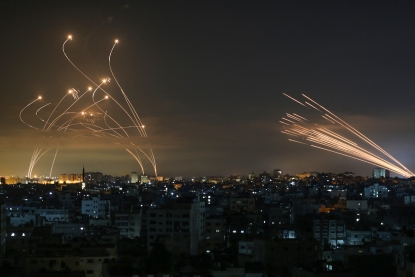 The Israeli Iron Dome missile defence system (L) intercepts rockets (R) fired by the Hamas movement towards southern Israel from Beit Lahia in the northern Gaza Strip on May 14, 2021 (AFP / Anas Baba) (AFP / Anas Baba)
The Israeli Iron Dome missile defence system (L) intercepts rockets (R) fired by the Hamas movement towards southern Israel from Beit Lahia in the northern Gaza Strip on May 14, 2021 (AFP / Anas Baba) (AFP / Anas Baba)
Rockets fired from Gaza began to rain on southern Israel. Many of them were shot down thanks to Israel’s Iron Dome anti-missile defence system. But others fell on the surrounding houses and fields. Under attack, Israel began to fire back that night of May 10.
In the days that followed, hundreds of rockets continued to fall from the sky, as thousands of Palestinians kept up demonstrations in the West Bank and east Jerusalem. Violence flared between Jewish and Israeli Arab residents of mixed towns and cities. In Lod, close to Tel Aviv, residents set fire to a synagogue after the father of an Arab family was shot dead a week earlier.
On the night of May 10, as Israel hit back there were fears of what was going to happen. Was this going to be a 48-hour flare-up of violence as seen in the past? Or was this leading to a fourth war in Gaza?
“I left home and I went to the office, as we were filming live the strikes from the office terrace,” said AFP’s video journalist Yahya Hassouna.
“My wife called me in tears. I told her, ‘I’ll see you after the war .. I didn’t want to tell her I was on the ground reporting, in the hospitals, there where the bombs were falling.
“The hardest thing for journalists in Gaza is pressure from your family. For 10 days I didn’t see my parents, they called me all the time to tell me ‘Be careful, don’t go to the danger zones, try to sleep’. And I replied, ‘I’m OK, I’m happy’. But they live in the centre of Gaza and knew very well that the bombs were falling everywhere, they could hear them. And my wife pleaded with me to go home.”
Photographer Jack Guez also left his family in Tel Aviv to spend days and nights in Ashkelon, in southern Israel, close to the Gaza Strip which Hamas had promised to turn into “hell”.
“It was very intense, with rockets and alerts all through the night. I was in an hotel, but with the amount of bombings and rocket alerts it was impossible to close your eyes. You hear ‘Boom’, and you tell yourself it’s OK, it didn’t hit the hotel, not this time. I could have fallen victim to the rockets in my hotel room.”
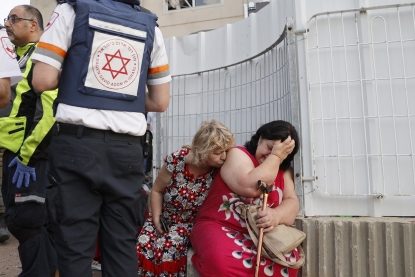 Israeli rescue teams help two shocked residents after a rocket attack on Ashkelon, on May 11, 2021 (AFP / Jack Guez)
Israeli rescue teams help two shocked residents after a rocket attack on Ashkelon, on May 11, 2021 (AFP / Jack Guez)
In this town of 150,000 residents, about 30 people were wounded, including five children in just one day on May 11, according to the emergency services.
“For 11 days I was driving around and I didn’t attach my seat-belt,” Guez said. “It was so I could dash out of the car if I needed to. I always remember what happened to my friends from AP and Reuters when their car was struck by a missile.
“It was much more intense than past wars that I covered. In the other wars I would hear the whistling of maybe three, four, five or six rockets launched at once .. but here I was under a hail of rockets. At times the sky was white with rocket trails, and I didn’t know whether I should work or take shelter to protect myself. Once a piece of one rocket hit me on the shoulder. Those 11 days scarred me more than all the previous wars.”
 A damaged house in the southern Israeli city of Ashkelon on May 11, 2021, after rockets were fired from the Gaza Strip (AFP / Jack Guez)
A damaged house in the southern Israeli city of Ashkelon on May 11, 2021, after rockets were fired from the Gaza Strip (AFP / Jack Guez)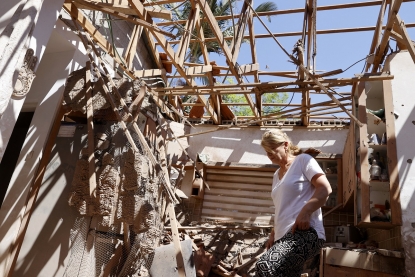 An Israeli inspects the damage to their house following a rocket attack in the southern Israeli city of Sderot on May 15, 2021 (AFP / Jack Guez)
An Israeli inspects the damage to their house following a rocket attack in the southern Israeli city of Sderot on May 15, 2021 (AFP / Jack Guez)
During those 11 days, about a dozen AFP photographers and videographers were deployed with Guez to cover the violence from Jerusalem, to Tel Aviv, in the north of Israel close to the Lebanese border and in the West Bank. They were constantly driving back and forth between their homes and the zones affected by the tensions. And it was not without danger, as even though the Iron Dome system intercepted many of the rockets, the debris would randomly fall to the ground.
 Sigal Harieli , at her destroyed home in Israel's southern city of Ashkelon on May 25, 2021 after it was hit by a rocket attack from the Gaza Strip earlier on May 20 (AFP / Menahem Kahana)
Sigal Harieli , at her destroyed home in Israel's southern city of Ashkelon on May 25, 2021 after it was hit by a rocket attack from the Gaza Strip earlier on May 20 (AFP / Menahem Kahana)“My family was always on my mind as they live in a town close to Gaza. As soon as I heard of a rocket warning for that town, my first priority was to call my kids,” said Guez.
"It was much harder than the other rounds of violence, because they were much more limited in the targeted areas, it was mostly the border with Gaza, (the towns of ) Sderot and Ashkelon,” agreed videojournalist Nir Kafri, who is based in the Tel Aviv area.
He said “the rockets hit our area” where he lives “so we also got the stress of the family”. On the first night, he and his wife were returning home from a family visit when “we suddenly heard the sirens on the radio, they were naming the places targeted.”
 Israelis take cover under a bridge at the entrance of the central city of Tel Aviv, on May 11, 2021, after rockets were launched towards Israel from the Gaza Strip (AFP / Gil Cohen-magen)
Israelis take cover under a bridge at the entrance of the central city of Tel Aviv, on May 11, 2021, after rockets were launched towards Israel from the Gaza Strip (AFP / Gil Cohen-magen) People take shelter behind a car in Tel Aviv, after rockets sirens are activated, following reports of projectile launches from the Gaza Strip on May 11 2021 (AFP / Jack Guez)
People take shelter behind a car in Tel Aviv, after rockets sirens are activated, following reports of projectile launches from the Gaza Strip on May 11 2021 (AFP / Jack Guez)His wife opened the car window and said: “I hear the sirens outside. It is not on the radio. There are rockets all over us.” They stopped when their daughters, who they had left at home, called to say “there are sirens, we don’t know what to do.” “It was like a scary movie,” Kafri said.
- A 360-degree war -
 (AFP / Mahmud Hams)
(AFP / Mahmud Hams)
In war zones, journalists often go to the frontlines and then at night return to their hotel or their homes, depending on whether they have been parachuted into the conflict or live in the area. So there’s a frontline and rear base, and sometimes airstrikes that come from the sky. But in Gaza it was a 360-degree war.
In this enclave, there is nowhere to go. No forward line, no rearguard position. Just war all around, from the skies and even in the ground beneath your feet, where Hamas built a labyrinth of tunnels. The families of the Gaza journalists weren’t safely miles from the fighting, protected from the violence. They were also living under the missile fire.
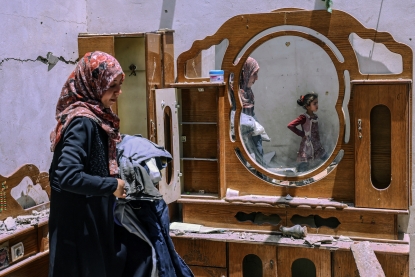 A women picks up what is left after her house was hit by a strike in Rafah, in the southern Gaza Strip on May 16, 2021 (AFP / Said Khatib)
A women picks up what is left after her house was hit by a strike in Rafah, in the southern Gaza Strip on May 16, 2021 (AFP / Said Khatib)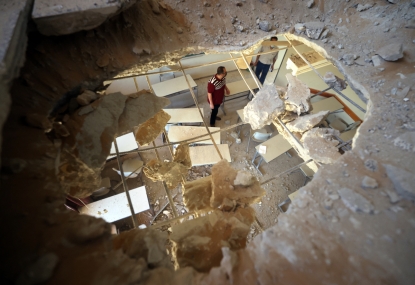 Palestinian men check items in a classroom at a school hit during shelling at the Zeitun neighbourhood in Gaza City, on May 27, 2021 (AFP / Thomas Coex)
Palestinian men check items in a classroom at a school hit during shelling at the Zeitun neighbourhood in Gaza City, on May 27, 2021 (AFP / Thomas Coex)
“There was no safe place. There was a constant fear and anguish for my family. We had to reassure each other every hour. That fear and anxiety combined with my sense of responsibility, that I had to do my job as a journalist,” said Adel Zaanoun, a veteran AFP reporter who usually replies when asked how he is with a cheerful “Double good”. Even, out of habit, during this conflict.
“The seventh day was the most difficult, when an Israeli raid destroyed the house of a close neighbour. My house was also damaged and my wife and children left,” he said. The lower walls of Zaanoun’s house were shattered and his windows blown out. His neighbour had received a call from the Israeli army warning him to leave, and saw his home reduced to a pile of rubble mixed with shoes, clothes and his children’s toys.
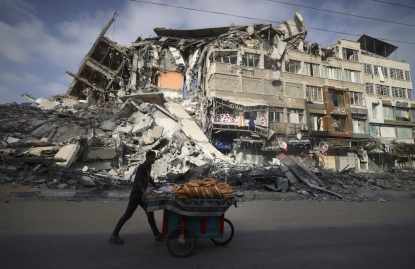 A Palestinian man walks past the destroyed Al-Shuruq building in Gaza City on May 20, 2021 after it was bombed by an Israeli air strike (AFP / Mahmud Hams)
A Palestinian man walks past the destroyed Al-Shuruq building in Gaza City on May 20, 2021 after it was bombed by an Israeli air strike (AFP / Mahmud Hams)
The doyen of the AFP bureau, Sakher Abou El Oun, had lost his only son Madhat, 13, to an illness just days before the conflict flared. He was at home in mourning with the rest of his family. “The bombs were pounding my district, al-Rimal, and my family and I were living with the sound of the bombs as they shook my house. We were so anxious. I’m not ashamed to say that my family and I took some sedatives. Several houses were targeted just next to mine. Many of my neighbours were killed.”
Fed-up of sitting at home, Sakher returned to work in the middle of the conflict to help his colleagues, to write a story about his destroyed neighbourhood and another about the trauma being suffered by the children. In one he described a child, almost a carbon copy of his teenage son, who repeatedly said: “I’m afraid, I’m afraid, I’m afraid.”
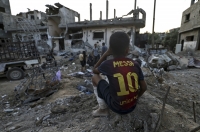
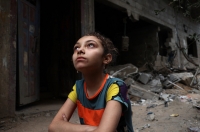
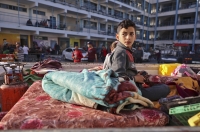

Seeing children in distress, triggered deep emotions for many including photographer Mahmud Hams.
“When you go to the morgue and you see children, you automatically think of your own kids. During the war I saw one boy who was heading there too. Someone shouted out; ‘Your father’s dead’. But the boy didn’t know and said ‘what?’. I began to cry.
Sometimes I cry when I am out reporting, but I try to hide it, to remain professional. But I’ve also realised sometimes it is necessary, it’s not good to keep everything inside. We’re humans, we’re not made of ice. We go to the hospitals, to the places which have been hit, we see whether people emerge alive or not from the debris.”
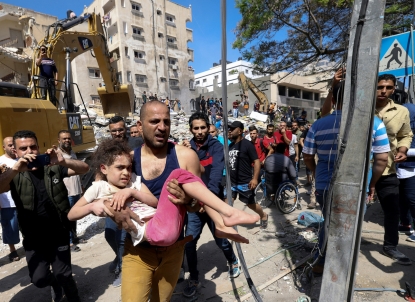 Palestinian Suzy Eshkuntana is carried to an ambulance by her father after being pulled out of the rubble of a destroyed building in Gaza City's Rimal on May 16, 2021. Suzy has lost her mother and siblings in this strike. (AFP / Mahmud Hams)
Palestinian Suzy Eshkuntana is carried to an ambulance by her father after being pulled out of the rubble of a destroyed building in Gaza City's Rimal on May 16, 2021. Suzy has lost her mother and siblings in this strike. (AFP / Mahmud Hams)
Prize-winning photographer Mohammed Abed had also cried “once” during the 2014 Gaza war, when he witnessed three-year-old Yamin being treated for his injuries in the operating room after being severely burned. He was the only survivor out of a family of 20. But this time he cried “twice”.
“I took a photo of a young boy on Wehda street who was looking for his family in the ruins. He collapsed, his head resting on the rubble and cried out ‘Mama, Mama.’ I cried. And I cried again when my daughter called me. She was following everything that was happening on social media, and kept sending me messages to tell me she was afraid. And I was afraid for her.”
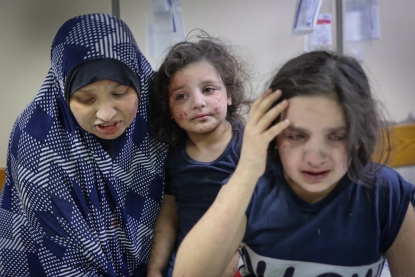 A Palestinian family arrives at Al-Shifa hospital after intensive bombardments on Gaza City, May 16, 2021. (AFP / Mohammed Abed)
A Palestinian family arrives at Al-Shifa hospital after intensive bombardments on Gaza City, May 16, 2021. (AFP / Mohammed Abed)- Jala Tower -
Saturday May 15 marked a turning point perhaps. Adel called me from Gaza. “AP and Al Jazeera have just been ordered to evacuate their building. They’ve got one hour to leave.“ The minutes passed. Carrying cameras, laptops and equipment the journalists working for the US news agency and the Qatari-based TV channel tumbled out of the building, the Jala Tower.
Outside the multi-storey tower, journalists from across Gaza gathered to watch and film the scene. Boom, boom. Like a giant Jenga building block game, the tower collapsed in a cloud of dust. One thought began to emerge to find somewhere to house the staff of AP and Al Jazeera. The teams knew each other, and appreciated each other. The telephones began ringing from Gaza to Jerusalem, Doha, Paris and New York. One call was key - to the AFP Gaza bureau technician Ahmed Eissa. The tower, which had been home to AP and Al Jazeera, had also housed antennas crucial for internet connections.
 The Jala Tower (highest building) housing international media outlets in Gaza city being hit by an Israeli air strike and collapsing on May 15, 2021 (AFP / Mahmud Hams)
The Jala Tower (highest building) housing international media outlets in Gaza city being hit by an Israeli air strike and collapsing on May 15, 2021 (AFP / Mahmud Hams)
“Jala tower was situated just next to where I live. When the warning was given I was supposed to go home to look after my children, wife, mother and father who live in the same building as me. But I couldn’t leave, because I knew that if the tower was hit it would be a disaster for the bureau as the internet would be cut off,” said Eissa.
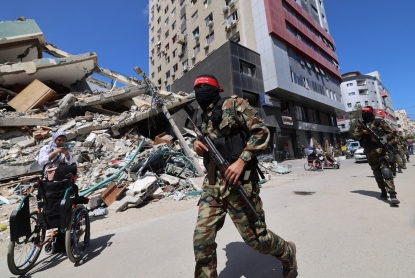 Masked fighters with the National Resistance Brigades (NRB), the military wing of the Democracy Front Liberation of Palestine (DFLP), walk in front of the ruins of the al-Jalaa tower on May 23, 2021 (AFP / Emmanuel Dunand)
Masked fighters with the National Resistance Brigades (NRB), the military wing of the Democracy Front Liberation of Palestine (DFLP), walk in front of the ruins of the al-Jalaa tower on May 23, 2021 (AFP / Emmanuel Dunand)
“So I called home and told my family to open the apartment windows so they wouldn’t shatter in the blast and told them to get as far away as possible. Since I also always plan for the worst, I had already put in place an IT back-up if ever there was a crisis. Our main two internet lines went down, so I connected to the third line and called the provider to boost the broadband connection. And that evening AP, Al Jazeera and we were all able to broadcast live from the AFP bureau,” said Ahmed Eissa.
On Friday May 21, after 11 days of relentless airstrikes on Gaza, and 4,300 rockets fired from the Strip on southern Israel, a ceasefire was declared following intense behind-the-scenes diplomatic efforts led by the US and Egypt. A semblance of normality began to return.
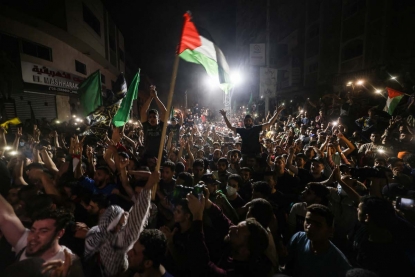 People celebrate in Gaza City after the ceasefire, early on May 21, 2021 (AFP / Mohammed Abed)
People celebrate in Gaza City after the ceasefire, early on May 21, 2021 (AFP / Mohammed Abed)
Israeli air strikes and artillery fire on Gaza killed 260 Palestinians, including 66 children and some fighters according to the Gaza authorities. In Israel 13 people were killed, including two children and a soldier, according to the police and army.
In Gaza one thousand buildings were also destroyed. “It’s as if all the air raids of the 2014 war (which lasted 50 days) were condensed into 11 days,” said Yahya Hassouna.
After the war “my wife hugged me and said, let’s go and celebrate Eid” , the feast which marks the end of Ramadan and which, this year, began 10 days late in Gaza.
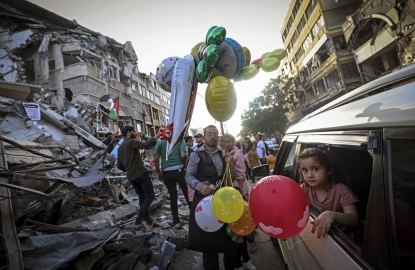 (AFP / Mahmud Hams)
(AFP / Mahmud Hams)
Now comes the reconstruction and rebuilding, but without the much-needed help of an army of counsellors to overcome the trauma. “After the 2014 war, I had some bad moments, I’d cry. And when there are military tensions, or fears of war, I am in a bad mood, because it’s as if all the wars are kaleidoscoping together. It’s a mistake to just tell the doctors ’everything is OK’. You need to talk,” said Mahmud Hams.
 (AFP / Mahmud Hams)
(AFP / Mahmud Hams)This blog was written by Guillaume Lavallée, with contributions of our reporters in Israel and the Gaza Strip. Translation by Jo Biddle.


